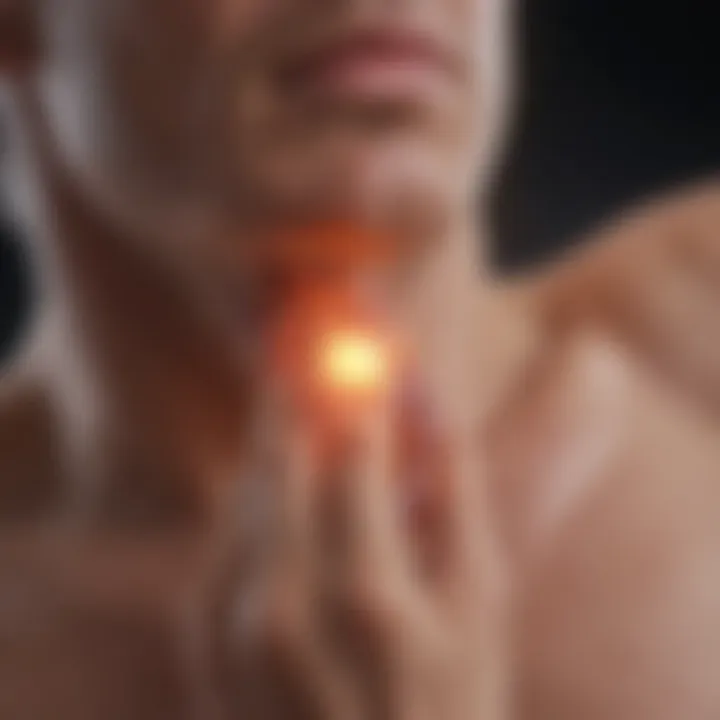Innovative Topical Creams for Neuropathy Relief


Intro
Neuropathy is a condition that results from damage to the peripheral nerves. This damage can lead to a variety of symptoms, including pain, tingling, and weakness in affected areas. Traditional approaches to neuropathy treatment often focus on medications or physical therapies. However, recent developments in topical treatments, particularly creams designed specifically for neuropathy, are gaining attention. These creams offer a non-invasive alternative, targeting localized symptoms directly at the site of discomfort.
Understanding the various underlying mechanisms of neuropathy is essential. Conditions such as diabetes, autoimmune diseases, and infections can precipitate nerve damage. Consequently, new topical formulations aim to address not only the symptoms but also the sources of nerve pain. In this overview, we will delve into key concepts related to neuropathy and its treatments, focusing primarily on the emerging topical creams.
Key Concepts
Definition of Primary Terms
Neuropathy refers to damage or disease affecting the peripheral nerves. This damage can arise from multiple causes, leading to varying symptoms. Topical creams are products applied directly to the skin. They are formulated to penetrate and affect underlying tissues, providing relief from symptoms.
Key terms include:
- Neuralgia: Pain due to inflammation or injury to a nerve.
- Neuroprotective agents: Substances that help preserve nerve function and structure.
- Transdermal delivery: The method by which active ingredients in creams are absorbed through the skin into the bloodstream or tissues.
Related Concepts and Theories
The development of topical creams for neuropathy treatment is grounded in a few critical concepts. For instance, the relationship between nerve health and inflammation is crucial. Inflammation can exacerbate nerve damage, so creams containing anti-inflammatory ingredients may help minimize symptoms.
Furthermore, research suggests that certain compounds, like capsaicin, can provide pain relief by desensitizing nerve receptors. Understanding the scientific basis behind these treatments enhances their appeal.
"Emerging research into topical treatments is transforming the approach to managing neuropathy, allowing patients to explore alternatives to systemic medications."
Future Directions
Gaps Identified in Current Research
Despite the progress, there remains a need for further research to address several gaps. Long-term efficacy studies on new formulations are still limited. Quantitative data is essential for proving the effectiveness of these creams over extended periods. Additionally, most studies tend to focus on a narrow subset of patients, leaving out diverse populations.
Suggestions for Further Studies
Future research should consider:
- Broader sample sizes: Including diverse populations to gather comprehensive data on effectiveness.
- Investigating combination therapies: Exploring how topical creams can work in conjunction with other treatment modalities.
- Longitudinal studies: Monitoring patients over an extended time can reveal insights into the creams' sustained benefits.
With the advancements in research and technology, the future holds promise for new creams aimed at treating neuropathy. These developments could significantly enhance patient care and quality of life.
Prelude to Neuropathy
Neuropathy is a complex condition characterized by damage to the peripheral nerves. Understanding this topic is crucial in the context of emerging treatments, particularly new topical creams designed for symptom relief. Neuropathy can severely affect quality of life, making it essential to explore not only its causes but also effective management strategies. This introduction sets the stage for a comprehensive analysis of the symptoms and treatment options available to patients.
Definition and Types of Neuropathy
Neuropathy refers to a wide range of conditions that affect the peripheral nervous system. This system is responsible for transmitting signals between the central nervous system and the rest of the body. There are several types of neuropathy, including:
- Diabetic neuropathy: Often a consequence of diabetes, leading to nerve damage.
- Alcoholic neuropathy: Resulting from excessive alcohol consumption, which can harm nerve function.
- Peripheral neuropathy: Generalized term for any nerve damage outside the brain and spinal cord.
- Hereditary neuropathy: Genetic factors causing nerve disorders.
Each type presents unique symptoms and requires tailored approaches for treatment. Understanding these distinctions helps in diagnosing and managing the condition effectively.
Epidemiology of Neuropathy
The prevalence of neuropathy varies globally depending on underlying health conditions, lifestyle factors, and demographics. According to research, it affects millions of people worldwide. Interestingly, studies indicate that approximately 60% to 70% of individuals with diabetes develop some form of neuropathy.
Beyond diabetes, factors like age, long-term alcohol use, and certain infections also contribute to its prevalence. The understanding of epidemiology is critical, not just for identifying at-risk populations, but also for guiding the development of targeted treatments, including topical creams aimed at specific types of neuropathy.
Understanding Neuropathy Symptoms
Understanding the symptoms of neuropathy is crucial for effective management and treatment. Neuropathy, characterized by nerve dysfunction, can manifest through a range of sensations and symptoms. Recognizing these symptoms allows both healthcare professionals and patients to make informed decisions regarding the appropriate interventions. Moreover, this understanding enables early diagnosis, which can significantly improve outcomes and enhance the quality of life for those affected.
Common Symptoms and Diagnosis
Neuropathy commonly presents with symptoms such as numbness, tingling, and pain in various parts of the body, often starting in the feet or hands. Patients may describe these sensations as burning, stabbing, or electric-like. Such symptoms can vary in intensity, affecting daily activities. Diagnosis typically involves a detailed medical history and neurological examination. This process may include specific tests such as nerve conduction studies or electromyography. These assessments help to pinpoint the underlying cause of neuropathy and tailor treatment approaches effectively.
Additionally, understanding these symptoms aids in recognizing potential complications, such as falls and injuries due to impaired sensation. Addressing these issues early can prevent further deterioration of the patient's condition.
Impact on Daily Life


The impact of neuropathy symptoms on daily life can be profound. For many, simple activities such as walking, cooking, or even typing can become challenging or painful. This disruption often leads to a decrease in physical activity, resulting in secondary health issues like obesity or depression.
Moreover, the psychological burden of living with unpredictable pain or discomfort can lead to anxiety and fear. Individuals may start to avoid social situations, which can lead to feelings of isolation.
"Many patients report that the emotional strain of neuropathy is just as significant as the physical symptoms."
Recognizing this multidimensional impact is essential in guiding treatment plans. A holistic approach that addresses both physical and emotional aspects can significantly enhance the overall quality of life. Effective management may include physical therapy to improve mobility, cognitive behavioral therapy for coping strategies, and alternative treatments like topical creams to alleviate symptoms.
In summary, understanding the symptoms of neuropathy not only facilitates diagnosis but also emphasizes the importance of a comprehensive treatment approach. It is imperative for both patients and healthcare professionals to remain vigilant about the range of symptoms and their effects on everyday life.
Conventional Treatments for Neuropathy
Conventional treatments for neuropathy play a crucial role in managing the condition and improving the quality of life for patients. These treatments encompass a variety of strategies aimed at alleviating symptoms, reducing pain, and addressing the underlying causes of neuropathy. While emerging therapies, such as topical creams, offer new hope, understanding conventional interventions provides a foundation for effective management.
Pharmacological Interventions
Pharmacological interventions are commonly utilized in neurology to manage neuropathic pain and associated symptoms. Medications almost mandatory in the management of moderate to severe pain due to neuropathy can include:
- Antidepressants: Agents like amitriptyline and duloxetine target pain pathways and help enhance serotonin and norepinephrine levels in the brain. They can be particularly effective for nerve pain.
- Anticonvulsants: Gabapentin and pregabalin are frequently prescribed to stabilize nerve activity and reduce excitability, thereby minimizing pain signals sent to the brain.
- Topical treatments: Over-the-counter options such as capsaicin cream and prescription medications, including lidocaine patches, can offer localized relief with fewer systemic side effects.
- Opioids: In some cases, opioids like morphine may be employed when other treatments do not provide adequate relief. However, they carry the risk of dependence and should be used cautiously.
While these pharmacological approaches can be effective, they often come with potential side effects. Patients using these medications need to have thorough discussions with their healthcare providers to evaluate benefits and risks based on individual circumstances.
Non-Pharmacological Approaches
Non-pharmacological approaches are essential components in a holistic treatment plan for neuropathy. These strategies may enhance the effectiveness of pharmacological interventions or serve as alternatives when medications are not well-tolerated. Some common non-pharmacological approaches include:
- Physical therapy: Tailored exercise regimens can help strengthen muscles, improve coordination, and reduce discomfort. Therapeutic physical maneuvers can aid in restoring functionality.
- Occupational therapy: Focusing on retraining individuals in daily tasks promotes independence and may reduce frustration stemming from neuropathic limitations.
- Alternative therapies: Acupuncture, chiropractic treatment, and massage can provide additional pain relief and enhance overall well-being. These therapies are often sought after when other treatments do not yield satisfactory results.
- Lifestyle modifications: Nutritional adjustments, enhanced sleep hygiene, and stress reduction techniques also contribute to improved management of neuropathic symptoms.
These non-pharmacological interventions can significantly augment traditional drug treatments, particularly in terms of improving patients' overall quality of life.
Together, the integration of pharmacological and non-pharmacological approaches gives a well-rounded strategy for treating neuropathy. Understanding and possibly combining these methods can empower patients and healthcare providers alike in their quest for effective management. As the landscape of neuropathy treatments evolves, the exploration of new topical creams presents exciting possibilities, necessitating further on-going research.
Emerging Treatments: The Role of Topical Creams
The realm of neuropathy treatment is seeing considerable evolution, particularly with the emergence of topical creams. These formulations are designed for local application, which can target areas of discomfort more directly than traditional systemic medications. The growing interest in these creams stems from the need for effective symptom relief with fewer systemic side effects. Patients and healthcare providers are increasingly looking for innovative solutions that empower individuals to manage their neuropathic pain better.
Mechanisms of Action for Topical Creams
Topical creams utilize a variety of active ingredients that work through multiple mechanisms. One primary pathway involves the modulation of pain perception at the local level. Ingredients such as capsaicin can deplete substance P, a neurotransmitter that transmits pain signals. Other formulations may include non-steroidal anti-inflammatory drugs (NSAIDs) or lidocaine, which provide pain relief by blocking nerve signals.
Additionally, some formulations aim to enhance circulation to the affected areas, which can promote healing and further alleviate symptoms. The specific mechanism of action can vary widely depending on the ingredients used and their concentrations. Patients should consult their healthcare provider to select a cream that aligns with their individual symptoms and conditions.
Advantages of Topical Applications
Topical creams offer several key advantages compared to oral medications and other forms of intervention:
- Localized Treatment: Topical creams deliver medication directly to the affected area, maximizing therapeutic effects while minimizing systemic exposure.
- Reduced Side Effects: By acting locally, many patients experience fewer side effects compared to oral medications, which can affect the entire body.
- Ease of Use: The non-invasive application method is straightforward and requires no special tools or training, enhancing patient compliance.
- Quick Relief: Many topical creams provide rapid onset of relief, making them an attractive option for acute symptoms.
"Topical treatments serve as a bridge between efficacy and safety for neuropathy patients seeking relief without extensive medication regimens."
In summary, topical creams are a significant advancement in neuropathy management. They offer tailored treatment options, targeting symptom control while minimizing the adverse effects often associated with oral medications. As research continues and formulations evolve, these creams represent a promising avenue for the future of neuropathy treatment.
Overview of New Cream Formulations
In the exploration of emerging treatments for neuropathy, new cream formulations hold significant promise. These topical therapies offer a direct approach for symptom relief, which is essential for individuals suffering from this condition. Unlike oral medications, these creams allow for localized application, minimizing systemic side effects. This segment of the article focuses on various aspects that underpin the development and efficacy of these new formulations.
The importance of understanding new cream formulations lies in their ability to target neuropathic pain effectively. Specifically designed to penetrate the skin barrier, these creams deliver active ingredients directly to the affected areas. This not only enhances therapeutic outcomes but also improves the patient's quality of life. Knowledge of the specific components and innovations in formulation can guide healthcare professionals and patients in making informed choices.
Ingredients Used in New Creams
The composition of neuropathy creams is crucial for their effectiveness. Common ingredients include:
- Capsaicin: Derived from chili peppers, capsaicin reduces pain by depleting substance P, a neurotransmitter associated with pain signaling.
- Lidocaine: An anesthetic that temporarily numbs the area, offering immediate relief from discomfort.
- Menthol: Provides a cooling sensation, which can help mask pain and discomfort.
- CBD oil: Gaining popularity, it interacts with the endocannabinoid system to potentially relieve pain.
Each ingredient serves a specific purpose and can complement one another, enhancing the overall efficacy of the cream. This layered approach allows for better pain management and can address multiple symptoms concurrently.
Innovative Formulations
Innovative formulations are reshaping the treatment landscape for neuropathy. These creams not only include traditional ingredients but also leverage advanced technologies to enhance their performance.


Some notable advancements include:
- Nanotechnology: Smaller particles can increase the absorption of active ingredients, allowing for deeper penetration into the skin and more effective pain relief.
- Microneedle patches: These offer a novel delivery system, ensuring that active compounds reach deeper layers of the skin without the discomfort of injections.
- Sustained-release formulations: These designs are engineered to release medication over time, reducing the need for frequent applications.
Such innovations focus on improving patient compliance and maximizing therapeutic effects. As research continues, these formulations will likely become more sophisticated, catering to the unique needs of individuals with neuropathy.
"Topical creams represent a shift towards more patient-centered care in neuropathy treatment. These formulations reflect an ongoing commitment to enhance the lives of those affected by nerve pain."
In summary, the overview of new cream formulations highlights the intersection of research and clinical practice. As the field of neuropathy treatment evolves, both the ingredients used and the innovation behind the formulations play critical roles in optimizing patient outcomes. Understanding these elements undoubtedly fosters a deeper comprehension of neuropathy management.
Clinical Efficacy of New Creams
The clinical efficacy of new creams for neuropathy treatment is critical in evaluating their usefulness and effectiveness. Understanding how these creams work and their impact allows healthcare professionals to make informed decisions regarding patient care. This section will discuss recent clinical trials and the findings related to patient outcomes, highlighting the potential benefits and considerations when using these topical formulations.
Recent Clinical Trials
Recent clinical trials have emerged that assess the effectiveness of new topical creams in alleviating symptoms of neuropathy. Various studies have focused on specific ingredients such as capsaicin, lidocaine, and other novel compounds. For example, a recent trial involving a cream containing capsaicin demonstrated significant reductions in pain among participants suffering from diabetic neuropathy. The study highlighted the role of capsaicin in desensitizing pain receptors, providing relief from discomfort.
In another trial, researchers examined the use of a multi-ingredient formulation. The study showed that patients who used this cream experienced a marked improvement in sensory symptoms, including tingling and burning sensations. These findings support the emerging consensus that topical treatments can serve as viable adjuncts in managing neuropathy.
Patient Outcomes and Literature Review
Patient outcomes play a crucial role in determining the overall efficacy of these new creams. Literature reviews reveal a mixed bag of results; while some patients report significant relief, others may not experience the same benefits. This variability may stem from individual differences, including the type of neuropathy, the duration of symptoms, and even genetic factors that influence response to treatment.
"The effectiveness of neuropathy creams can vary widely among individuals, emphasizing the need for personalized treatment plans."
Several case studies indicate that consistency in application and adherence to recommended usage is key in achieving optimal results. The correlation between frequency of use and symptom relief demonstrates the importance of educating patients on how to apply these creams effectively.
In summary, ongoing clinical trials and patient outcomes underscore the potential of new creams in managing neuropathic symptoms. However, the individual response to treatment is crucial, and further research is necessary to tailor approaches that maximize efficacy for diverse patient populations.
Application Techniques for Optimal Results
The application of topical creams for neuropathy is an integral aspect that significantly influences treatment outcomes. Understanding the proper methods of applying these creams is crucial for enhancing efficacy. It is not merely about choosing the cream; the technique of application can affect the absorption and ultimately the results experienced by the patient.
Best Practices for Application
When considering best practices for applying topical creams, several key factors come into play:
- Cleanse the Skin: It is essential to start with clean, dry skin. Dirt, oils, or other contaminants can interfere with the absorption of the cream.
- Even Application: Apply a thin, even layer of the cream over the affected area. This ensures that the medication can spread uniformly without pooling.
- Gentle Massage: Use a gentle massaging motion to work the cream into the skin. This can enhance absorption and increase circulation in the area. Avoid rubbing too hard, as this can irritate the skin.
- Follow Product Instructions: Different creams may have specific instructions. Always read and follow the guidelines provided with the cream for optimal results.
Observing these practices maximizes the therapeutic potential of the cream and can lead to quicker relief from neuropathy symptoms.
Frequency and Duration of Use
The frequency and duration of applying these creams are equally important. Over-application does not necessarily lead to better results and can sometimes cause skin irritation. Here are some considerations regarding frequency and duration:
- Recommended Schedule: Most topical creams suggest application two to three times a day. Adhering to this schedule is important to maintain consistent levels of medication on the skin.
- Duration of Treatment: Patients should be mindful of how long to continue using the cream. Many formulations recommend ongoing use until symptoms improve, but changes in skin conditions or side effects should prompt a discussion with a healthcare provider.
- Assessing Effectiveness: Regular monitoring of symptom changes is critical. If significant improvement is observed within a few weeks, the application frequency might be adjusted accordingly. However, any lack of improvement or the emergence of side effects should be reported.
Applying topical creams effectively and consistently can greatly enhance their benefits in managing neuropathy symptoms. Proper techniques should facilitate better absorption and lead to improved patient outcomes.
Safety Profile and Adverse Effects
The effectiveness of any treatment is invariably linked to its safety profile. In the context of neuropathy creams, understanding the safety and potential adverse effects is critical for both patients and healthcare providers. With topical applications becoming a prominent choice for symptomatic relief, it is essential to weigh their benefits against possible risks.
When assessing a cream’s safety, various factors come into play, including ingredient composition, concentration levels, and delivery methods. This ensures that while patients seek relief, they do not inadvertently expose themselves to additional health risks. Knowing the common side effects and contraindications can guide users in making informed choices regarding their treatment options.
Common Side Effects
Despite the localized application of neuropathy creams, some users may experience side effects. These adverse effects can range in severity and frequency. Common side effects associated with these creams include:
- Skin Irritation: Redness, itching, or a burning sensation is not uncommon and may occur at the application site.
- Allergic Reactions: Some individuals may have sensitivities to specific components, leading to rashes or hives.
- Dryness or Peeling: Prolonged use can sometimes result in skin dryness for sensitive skin types.
- Changes in Skin Color: In rare cases, application may lead to hyperpigmentation in the treated areas.
It’s important for patients to monitor these reactions closely. They should discontinue use immediately if they experience severe reactions, such as difficulty breathing or swelling.
Contraindications
Contraindications refer to specific situations or conditions under which a treatment should not be used. For neuropathy creams, these include:
- Known Allergies: Individuals with a history of allergies to certain compounds found in the cream should avoid use.
- Open Wounds or Skin Conditions: Applying cream to broken skin can increase the chance of systemic absorption and side effects.
- Pregnancy and Nursing: Pregnant or breastfeeding women should consult healthcare providers before using topical neuropathy creams due to the lack of comprehensive studies on safety.
- Children and Adolescents: Many formulations have not been tested extensively in younger populations, raising concerns about safety and efficacy.


Patients should always consult with a healthcare professional to discuss their specific medical history and current conditions before starting a new treatment. Being aware of these contraindications can prevent adverse effects and ensure a more favorable experience with neuropathy creams.
The importance of understanding the safety profile cannot be overstated. It empowers patients to make informed decisions about their treatments, ultimately leading to better outcomes.
Patient Experiences with Neuropathy Creams
Patient experiences with neuropathy creams play a significant role in understanding the effectiveness and usability of these topical treatments. Neuropathy is a complex condition with varied symptoms and causes. As a result, how individuals respond to treatments can differ drastically based on numerous factors, including the type of neuropathy, underlying health conditions, and personal preferences regarding medication.
Understanding these experiences can provide both healthcare professionals and patients with invaluable insights. First, they highlight the practical aspects of using these creams, which can range from ease of application to the presence or absence of adverse reactions. Second, testimonials and case studies serve as qualitative data that can guide future research and development of neuropathy treatments.
Moreover, analyzing patient feedback enables practitioners to tailor their approaches, ensuring that patients receive the most suitable treatment plans. The personal nature of these experiences often sheds light on the subjective nature of pain management, making them crucial to consider when discussing neuropathy treatments.
Case Studies and Testimonials
Case studies and testimonials from patients offer rich qualitative insights into the effects of neuropathy creams. For example, one case study details a 54-year-old woman suffering from diabetic neuropathy who reported significant relief after using a cream containing capsaicin. This patient noted decreases in both pain and the burning sensations that had plagued her daily life. Such anecdotal evidence can sometimes illustrate what clinical trials may not fully capture—personal relief and improved quality of life.
Another testimonial comes from a male patient in his 60s who applied a menthol-containing cream. He described a sensation of cooling and numbness that offered immediate respite from his symptoms, allowing him to engage more actively in hobbies he loved.
These accounts can aid in understanding how various formulations resonate with users, shaping expectations and informing other patients about potential outcomes. However, while useful, it is essential to approach these patient accounts with some caution. Each individual's experience is unique, and outcomes can be influenced by various external factors such as compliance, lifestyle, and other medications.
Variability in Individual Responses
Variability in individual responses to neuropathy creams is an important consideration. Not every patient will experience the same level or type of relief from symptoms, and several factors can influence this variability.
- Biological Variations: Genetics and metabolism can affect how one’s body responds to topical treatments. Some individuals may metabolize active ingredients more efficiently, leading to enhanced effects, while others may experience minimal benefits.
- Condition Specifics: The underlying cause of neuropathy matters. For instance, patients with chemotherapy-induced neuropathy may react differently compared to those with diabetic neuropathy because the mechanisms of nerve damage differ significantly.
- Product Formulation: The composition and concentration of active ingredients in neuropathy creams can also lead to different results. A stronger formulation may benefit some patients but could lead to adverse effects in others.
In summary, understanding the variability in responses aids in recognizing that one solution may not fit all. Tailoring recommendations based on individual experiences ensures better patient care and optimizes therapeutic outcomes.
"Patient feedback is a critical element in refining treatment protocols and developing new therapies that can better serve the neuropathy population."
Future Directions in Neuropathy Treatment
The significance of exploring future directions in neuropathy treatment is paramount in light of the increasing prevalence of neuropathy worldwide. Research and development in this area aim to uncover more effective treatments that can improve patient outcomes. Emerging methodologies are vital as they can lead to innovations that address the unmet needs of those afflicted by the condition. Focusing on future treatments can illuminate potential pathways for therapies that are not merely palliative but also restorative. This section will delve into two main aspects of future directions in neuropathy treatment: ongoing research initiatives and potential innovations in formulation.
Ongoing Research Initiatives
The landscape of neuropathy treatment is evolving, driven by ongoing research initiatives that are exploring new therapeutic avenues. Various clinical trials are currently investigating the efficacy of different formulations and active compounds. These studies aim to determine how specific ingredients may target neural pathways affected by neuropathy. For instance, researchers are examining the use of cannabinoids, known for their analgesic properties, as part of topical treatments. Additionally, there is interest in exploring neuroprotective properties of compounds found in natural products, which show promise in reducing pain and enhancing recovery.
Moreover, collaborative efforts among universities, pharmaceutical companies, and healthcare institutions are becoming increasingly common. These partnerships enable the pooling of resources and knowledge, fostering innovative thinking in neurology. Furthermore, advancements in drug delivery systems are also being researched. Enhanced absorption techniques can increase the effectiveness of topical creams while minimizing systemic side effects.
Research initiatives stand to contribute significantly to improved treatment paradigms for neuropathy. The findings from these studies will not only expand the range of available treatments but also refine the existing ones, optimizing their impact on patients' quality of life.
Potential Innovations in Formulation
Innovations in formulation are critical in the realm of neuropathy treatment. The future may see creams that incorporate advanced technologies aimed at improving efficacy. For example, nanoparticles are being explored for their ability to deliver medications more precisely to target areas. This targeted delivery can enhance the bioavailability of active ingredients while reducing potential side effects.
Additionally, there is ongoing research into biocompatible materials that synergize with the body's own systems. Formulations that support nerve regeneration or reduce inflammation could shift the focus from simply alleviating symptoms to addressing underlying causes of neuropathy.
Another emerging trend is the customization of creams, where therapeutics are tailored to the individual patient's needs. Genetic factors can influence how a patient responds to a particular cream; thus, personalized formulations may offer more effective solutions.
- Key aspects to consider include:
- Enhanced targeting of active ingredients
- Potential for personalized or tailored treatments
- Incorporation of new materials and technologies
With these innovations, manufacturers can develop advanced topical creams that may drastically change the therapeutic landscape for neuropathy management. These potential breakthroughs will not only improve therapeutic effectiveness but also reshape patient experiences.
Culmination
The conclusion of this article encapsulates the necessity and potential of new creams for neuropathy treatment. As healthcare continues to evolve, focusing on targeted topical applications offers hope and relief for many individuals suffering from neuropathy. Understanding these treatments requires a clear look at their formulation, efficacy, and patient-centric outcomes.
Summary of Findings
New creams designed for neuropathy incorporate specific ingredients that target pain modulation and inflammation reduction. Clinical trials indicate varying levels of effectiveness, with some patients reporting significant improvement in their symptoms. The evidence also suggests that these creams might offer fewer side effects compared to traditional oral medications. Innovations in formulation continue to emerge, underscoring the dynamic nature of this field. Key points from this article include:
- Ingredients: Local anesthetics, capsaicin, and various botanical extracts are common in newer formulations.
- Efficacy: Recent studies show positive results, with patient-reported improvements.
- Application: Best practices enhance efficacy and patient compliance.
"As topical treatments gain traction, they may redefine how we approach neuropathic pain management in clinical settings."
Implications for Practice
Healthcare providers must consider these emerging products as part of a comprehensive neuropathy management strategy. The use of topical creams provides an opportunity for personalized treatment, where clinicians can tailor therapy according to patient needs and preferences. Additionally, education about proper application techniques and realistic outcome expectations is crucial.
- Patient Education: Providers should inform patients about potential benefits, risks, and application methods.
- Monitoring Outcomes: Ongoing assessment of treatment effectiveness will drive future advancements.
- Research Collaboration: Engaging in clinical studies can foster continued development of these topical treatments, aligning clinical practice with scientific progress.
This thoughtful integration of new creams into neuropathy management supports a shift towards more individualized care. The evolving landscape of treatment options provides clinicians and patients with actionable insights that can positively influence quality of life.



